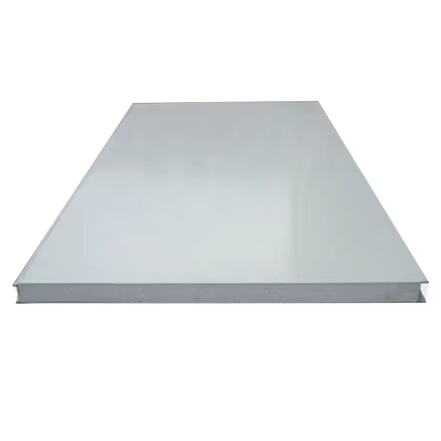Introduction to Polyurethane Sandwich Panels
What Are Polyurethane Sandwich Panels?
Polyurethane Sandwich Panels, often known as sandwich panels, are integral components in modern construction, acclaimed for their multifaceted utility. These panels consist of a core insulation material, typically polyurethane foam, compressed between two durable outer layers, commonly metal. This structure not only provides exceptional thermal insulation and soundproofing but also enhances the overall strength of the panels, making them ideal for walls and roofs in diverse settings. Available in a range of thicknesses and dimensions, these panels cater to varied construction needs, ensuring both energy efficiency and structural integrity.
Why They Matter in Modern Construction
Polyurethane Sandwich Panels have become pivotal in modern construction due to their significant contribution to energy efficiency. In contemporary architecture, reducing operational energy costs is paramount, and these panels excel in maintaining thermal consistency, thereby minimizing energy consumption. Their use in building improves performance while aligning with the growing trend towards sustainability and eco-friendly materials. As urbanization progresses, the construction industry increasingly emphasizes sustainable practices, making these panels an essential component in green and energy-efficient building initiatives.
Key Benefits of Polyurethane Sandwich Panels
Superior Thermal Insulation Properties
Polyurethane sandwich panels are renowned for their outstanding thermal insulation properties, making them a preferred choice in construction. The polyurethane core has a low thermal conductivity, which significantly reduces heat transfer, leading to energy savings. According to industry data, these panels can reduce energy usage for heating and cooling by up to 30%. When compared to traditional insulation materials like fiberglass and polystyrene, polyurethane panels offer superior R-value, a measure of thermal resistance, ensuring better temperature control within buildings. This comparative advantage not only lowers operating costs but also contributes to a smaller carbon footprint, aligning with sustainable building practices.
High Strength-to-Weight Ratio
One of the notable characteristics of polyurethane sandwich panels is their high strength-to-weight ratio. This is achieved through the combination of a sturdy core and durable outer layers, allowing the panels to be both lightweight and robust. This quality facilitates easier transportation and installation, saving on both logistics and labor costs. Moreover, construction designs benefit from the reduced structural load without compromising on strength, as evidenced by numerous engineering Projects that seamlessly integrate these panels for enhanced architectural innovation and efficiency.
Moisture and Fire Resistance Capabilities
Polyurethane sandwich panels excel in their moisture and fire resistance capabilities, crucial for ensuring building safety and longevity. The panels exhibit excellent moisture barrier properties, protecting against dampness and mold, which can compromise structural integrity over time. In terms of fire resistance, these panels have been rigorously tested and meet stringent safety regulations. Polyurethane's composition minimizes smoke production and toxicity in the event of a fire, making it an ideal material for buildings where fire safety is paramount.
Long-Term Durability in Harsh Climates
Designed to withstand extreme weather conditions, polyurethane sandwich panels provide long-term durability that thrives under harsh climates. Extensive durability testing has shown that these panels maintain their integrity and performance across a wide range of temperatures and environmental exposures, from arid deserts to freezing winters. The longevity of these panels is backed by industry benchmarks that validate their resilience, ensuring they remain a reliable choice for structures requiring steadfast endurance in challenging climates.
Applications in Modern Construction
Residential Building Envelopes
Insulation plays a crucial role in the energy efficiency and comfort of residential buildings, and polyurethane panels are an outstanding choice for this purpose. These panels offer superior insulation performance, maintaining consistent indoor temperatures and reducing the need for excessive heating or cooling. Their design flexibility allows architects to integrate them seamlessly into various home construction styles, boosting both thermal efficiency and aesthetic appeal. Several residential projects across Europe and North America have successfully utilized polyurethane panels, demonstrating their ability to achieve energy savings while maintaining modern design standards.
Commercial Roofing Systems
In the domain of commercial roofing, polyurethane panels are increasingly popular due to their excellent performance and durability. These panels offer outstanding thermal insulation, contributing significantly to reduced energy costs in commercial buildings. According to industry testimonials, the use of polyurethane panels in commercial settings enhances resistance to weather extremes, preserving the structural integrity of the buildings over time. Projects such as corporate headquarters and shopping malls have seen significant performance improvements, with building managers noting increased thermal efficiency and the added benefit of soundproofing.
Industrial Cold Storage Facilities
The role of insulation in cold storage facilities cannot be overstated, and polyurethane panels lead the way in providing optimum performance. These panels offer exceptional thermal insulation, maintaining the low temperatures required for preserving perishables such as food and pharmaceuticals. Compared to traditional materials, polyurethane panels deliver significant operational cost savings through their energy-efficient properties. Data from cold storage facilities illustrate a marked improvement in energy consumption, validating the cost-effectiveness of choosing polyurethane over less efficient insulation options.
Prefabricated Modular Structures
Polyurethane panels are a game-changer in the prefabricated modular building sector due to their efficiency and speed in construction. These panels facilitate rapid assembly, drastically reducing construction timelines and labor costs. The benefits extend to material savings, as their remarkable insulation properties mean fewer materials are needed overall for similar thermal performance. Statistics indicate a rising trend in modular construction across North America and Europe, with polyurethane panels driving this growth by delivering both sturdiness and flexibility tailored to prefabricated designs.
Installation & Maintenance Best Practices
Step-by-Step Installation Guidelines
Correctly installing polyurethane sandwich panels is crucial for maximizing their performance benefits. The installation involves several key steps, starting with a thorough site preparation. Begin by ensuring that all surfaces are clean, dry, and level to support the panels. Next, mark the installation area, taking into account any architectural requirements or design patterns. Secure the panels using appropriate screws and fasteners; using concealed screws can offer a seamless finish. Common pitfalls during this process include improper alignment and over-tightening of screws, which can lead to panel damage. Referencing visual aids such as diagrams or digital guides can be beneficial, providing visual cues to enhance precision during installation.
Ensuring Airtight Seals for Maximum Efficiency
Achieving airtight seals between polyurethane panels is essential to minimize energy loss and ensure optimal insulation. Proper sealing of joints and transitions is required, with recommended materials including polyurethane foam sealants and specialized tape. These materials facilitate a tight seal, preventing air leakage. Techniques such as double-sealing and using compression gaskets can enhance airtightness. Statistically, buildings with airtight installations observe a notable increase in energy efficiency, with savings up to 30% on heating and cooling costs annually, demonstrating the importance of these practices.
Long-Term Maintenance Strategies
Ensuring the longevity and performance of polyurethane sandwich panels involves implementing strategic maintenance practices. These panels require periodic inspections to check for any signs of wear, corrosion, or moisture ingress. Routine maintenance may include cleaning the panels to remove dirt and debris that can accumulate over time, thus sustaining their appearance and functionality. Manufacturers often recommend inspections every six months and prompt repairs of any detected damages or seam issues. Adhering to these recommendations can significantly extend the lifespan and efficiency of the panels, providing long-term benefits for building structures.
Cost Analysis and Sustainability
Initial Investment vs. Lifetime Energy Savings
When considering polyurethane sandwich panels for construction, an analysis of the initial investment versus lifetime energy savings is crucial. Initially, these panels might present higher costs compared to traditional materials like brick or concrete due to their specialized composition. However, their superior insulating properties lead to significant energy savings over time. For example, the excellent thermal insulation provided by polyurethane cores can reduce heating and cooling costs by maintaining the desired indoor climate with less energy consumption. This results in a compelling return on investment (ROI) over the panel's lifespan, as lower energy bills and maintenance costs compensate for the upfront expense.
Recyclability and Reduced Carbon Footprint
Polyurethane sandwich panels contribute to sustainable construction practices by offering recyclability and reducing carbon footprints. The panels are designed to have a minimal environmental impact throughout their lifecycle. The production process can incorporate recycled materials, and at the end of their life, panels can be dismantled and recycled. Moreover, polyurethane panels help decrease energy usage, indirectly lowering CO2 emissions associated with heating and cooling. Regulatory incentives are also frequently in place to promote such sustainable building materials, aligning with guidelines for green construction.
Meeting Green Building Certifications
Meeting green building certifications is increasingly important in the construction industry, and polyurethane sandwich panels can be pivotal in achieving these standards. Certifications like LEED (Leadership in Energy and Environmental Design) require high-performance insulation materials that enhance energy efficiency and reduce environmental impact. Polyurethane panels are ideal due to their insulating capabilities and environmental benefits. Statistics indicate a rising demand for green certifications, reflecting the growing industry emphasis on sustainable building practices. These panels help projects align with industry standards, making them advantageous for environmentally conscious construction efforts.
FAQ
What are the main benefits of using polyurethane sandwich panels?
Polyurethane sandwich panels provide superior thermal insulation, a high strength-to-weight ratio, and excellent moisture and fire resistance capabilities. They are also durable in harsh climates, making them ideal for various construction applications.
Why are polyurethane panels preferred over other insulation materials?
Polyurethane panels offer exceptional thermal performance with a higher R-value compared to materials like EPS, XPS, and mineral wool. They provide better moisture resistance and long-term durability, enhancing energy efficiency and building integrity.
How do polyurethane sandwich panels support energy-efficient building practices?
These panels significantly reduce heat transfer, leading to lower energy consumption for heating and cooling. They are instrumental in meeting green building certifications and contribute to a reduced carbon footprint, aligning with sustainable construction practices.
What should I consider during the installation of polyurethane panels?
Careful alignment, ensuring airtight seals, and using appropriate fasteners are crucial for effective installation. Routine maintenance and inspections are also recommended to sustain their performance and longevity.
Are polyurethane sandwich panels recyclable?
Yes, polyurethane sandwich panels are designed to have a minimal environmental impact and can be dismantled and recycled at the end of their lifecycle, supporting sustainable building initiatives.

 EN
EN







































